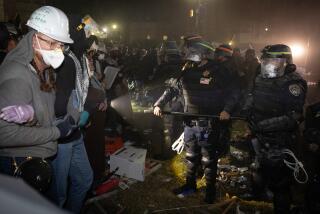Gov. puts global spin on case for new dams
In proposing two big, expensive dam projects this week, Gov. Arnold Schwarzenegger made a novel argument to justify the old-fashioned public works projects.
Advocating $4 billion in bonds to build reservoirs in Northern and Central California, the administration emphasized not population growth or the specter of future drought, but global warming.
As temperatures rise, California’s mountain snowpack will shrink, leaving a storage void the administration says should be filled in part with new reservoirs.
“This administration is taking the lead in this country to deal with greenhouse gases,” state Department of Water Resources Director Lester Snow said. But “no matter what we do now, we continue to have changes in snowpack and runoff patterns.”
Each 1-degree rise in temperature pushes the mountain snow line 300 feet higher, meaning that as California warms, more precipitation will fall as rain in winter storms and less as slow-melting snow, increasing the flood threat and making it harder to capture mountain runoff.
“The forecast -- and these are fairly conservative forecasts,” Snow said, “is that by 2050 we will have lost 25% of the snowpack in the Sierra.... If we don’t take management action to accommodate that, we will wind up with both flood and water-supply issues.”
GOP-backed administration proposals for new water storage projects sank last year amid Democratic opposition, and dam proponents said the chances of getting the reservoir plans through the Democrat-controlled Legislature this year are slim.
“I think we know a bit more about the effects of climate change in California,” said Steve Hall, executive director of the Assn. of California Water Agencies, which supports new reservoirs. “But in the end I’m not sure it is enough to convince a majority of legislators to vote for it.”
Both proposed reservoirs have been under consideration for years.
One would dam canyons and flood 14,000 acres of ranch country, including the tiny Colusa County settlement of Sites, 77 miles north of Sacramento. To lessen environmental damage, the reservoir would not be constructed on the Sacramento River but some 16 miles to the west.
Existing irrigation canals or a new billion-dollar pipeline would carry water from the river to the reservoir, which would hold roughly 1.8 million acre feet of water, less than half the capacity of Shasta Lake, the state’s biggest reservoir.
The second reservoir, called Temperance Flat, would be built on the San Joaquin River east of Fresno, just upstream from the existing Friant Dam and Millerton Lake.
It would hold up to 1.3 million acre feet.
“I think we need more storage anyway for dry years, and climate change just makes it worse,” said the state’s chief hydrologist, Maury Roos.
Sen. Darrell Steinberg (D-Sacramento), who heads the Senate Natural Resources and Water Committee, which would review the reservoir package, said alternatives for developing new water supplies, such as ground water storage and conservation, should be evaluated.
Moreover, Natural Resources Defense Council policy analyst Barry Nelson said the Temperance Flat reservoir is in the wrong place to counter the effects of global warming because the high peaks of the Central and Southern Sierra are expected to experience less snowpack loss than mid-elevation mountains to the north.
“It’s more subsidized water for [agricultural] users in the San Joaquin Valley,” Nelson contended. “It has nothing to do with climate change.”
He also said the Sites reservoir would leave water supplies vulnerable to another aspect of global warming: rising sea levels in the Sacramento-San Joaquin Delta.
Water delivered to the south would have to go through the delta, which will get saltier as rising sea levels push ocean water farther upstream.
Jeffrey Kightlinger, general manager of the Metropolitan Water District of Southern California, said that although both Sites and Temperance Flat “would be useful, they are not, either one, really aimed at Southern California and our issues.”
More important for the region, Kightlinger said, is dealing with the many problems of the delta, which is where Northern California water is diverted south.
Delta levees could collapse in an earthquake, letting in more seawater, and a dramatic decline in delta fish populations could force changes in the pumping operations that send water south.
“We are quite concerned with our ability to move water through the delta and so without progress on conveyance issues in the delta, it’s unclear what value surface storage north of the delta would have,” Kightlinger said.
The administration is expected to soon appoint members of a blue-ribbon commission to examine delta issues and, along with the reservoir funding, is proposing $1 billion in bonds for delta projects.
The water package also includes $500,000 for local groundwater storage projects. And Snow indicated this week that the administration would be open to discussing a greater emphasis on ground water storage.
More to Read
Get the L.A. Times Politics newsletter
Deeply reported insights into legislation, politics and policy from Sacramento, Washington and beyond. In your inbox three times per week.
You may occasionally receive promotional content from the Los Angeles Times.







